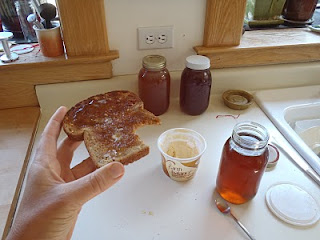 After living in close proximity to bee hives for the past year, my relationship with honey has bloomed, and the benefit isn't only in my taste buds. Like birding, bees connect me to my environment. I've spent hours speculating about where our backyard bees go during the day. Our landlord, whose bees these are, speculates they go to the Berkeley Aquatic Park, a greenbelt about a mile away. I plant bee-friendly flowers in my garden, and almost daily Jason and I watch the bees, whose hives are on the roof of an outbuilding behind our house. We watch them guard their hive, fly away in beautiful streams, buzz around our porchlight at night, and crawl slowly across our deck to die.
After living in close proximity to bee hives for the past year, my relationship with honey has bloomed, and the benefit isn't only in my taste buds. Like birding, bees connect me to my environment. I've spent hours speculating about where our backyard bees go during the day. Our landlord, whose bees these are, speculates they go to the Berkeley Aquatic Park, a greenbelt about a mile away. I plant bee-friendly flowers in my garden, and almost daily Jason and I watch the bees, whose hives are on the roof of an outbuilding behind our house. We watch them guard their hive, fly away in beautiful streams, buzz around our porchlight at night, and crawl slowly across our deck to die. Of course we've incorporated honey into our home cuisine, over yogurt, baked in banana bread, used in glazes for poultry, and in various marmalades and jams. We eat it by the spoonful when we feel like it, and stir it into our tea. It is delicious, nourishing and somehow we can feel its ancient essence. With dear friends we've started a batch of mead using our backyard honey and plums. In nine months I'll tell you how it turned out.
Of course we've incorporated honey into our home cuisine, over yogurt, baked in banana bread, used in glazes for poultry, and in various marmalades and jams. We eat it by the spoonful when we feel like it, and stir it into our tea. It is delicious, nourishing and somehow we can feel its ancient essence. With dear friends we've started a batch of mead using our backyard honey and plums. In nine months I'll tell you how it turned out. Paul, our landlord, keeps hives at our house, at his house across the street, and on properties in the Sierras (that honey tastes of manzanita and blackberry), Pt. Reyes (tastes buttery, with less citrus sweetness than ours), and near Coos Bay, Oregon (we haven't yet tried that one). Through his honey I learn a little about those other environments.
Paul, our landlord, keeps hives at our house, at his house across the street, and on properties in the Sierras (that honey tastes of manzanita and blackberry), Pt. Reyes (tastes buttery, with less citrus sweetness than ours), and near Coos Bay, Oregon (we haven't yet tried that one). Through his honey I learn a little about those other environments.A while ago I found Juliette Elkon's Honey Cookbook at the San Leandro Thrifttown, published by Knopf in 1955. It is a treasure. She collected recipes dating back to Medieval times that use honey as a primary ingredient. Here's one I haven't tried yet, but I plan to.
Russian Honey Beet Jam
1 pound beets
honey
2 preserved ginger roots, minced
almonds, sliced
Wash, peel, and cut beets into 1/2-inch slices, cook, and drain. Add one cup honey for each cup of beets and cook until thick.Flavor with ginger root and almonds. (Serve with cold meats.)
There are a lot of exotic honey recipes in the Honey Cookbook, but I have to admit that a few simple classics are very tough to beat. A toast to the glories of honey!
Photos of bees taken by Jason Swecker.

